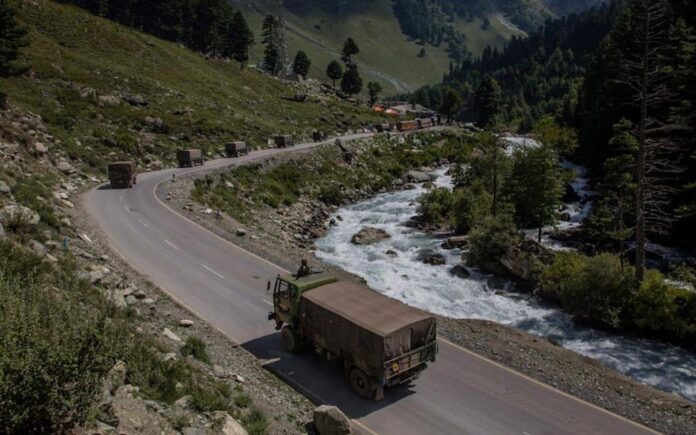When the snow melts on India’s mountainous border with China it usually reveals an empty landscape of sheer ridges and plunging valleys.
Border posts were once manned only by a handful of police armed with bats and clubs.
But this year satellites have been able to pick up a rapid military build-up on both sides that threatens to pitch the two nuclear-armed neighbours into war.
India has deployed 60,000 troops and heavy artillery to reinforce the border following clashes last year with Chinese soldiers in the Galwan Valley in Ladakh that left at least 24 dead.
China for its part has been conducting live-fire exercises with self-propelling mortars, chipping away at a 1996 agreement not to use guns or explosives near the border.
Analysts say that Delhi now faces the unenviable situation of having to maintain a heavy troop presence on two fronts, amid a shaky ceasefire with the old enemy Pakistan to the west.
“The Chinese threat has increased substantially and it is growing because of the capabilities that the People’s Liberation Army (PLA) is inducting in the theatre… Right now there is no war but when you increase the threat, a war can never be ruled out,” said Pravin Sawhney, analyst and editor of national security magazine Force.
Chinese troops crossed the 3,800km border, known as the Line of Actual Control, in May 2020 and set up new border posts. The Telegraph reported on similar incursions into Nepal and Bhutan.
In a series of bloody hand-to-hand clashes in Galwan Valley at least 20 Indian police were beaten to death, their bodies pushed down steep ravines. China later admitted four of its own soldiers were killed.
India’s prime minister, Narendra Modi, was accused by the opposition of kowtowing to China’s president Xi Jingping over the incursion, amid widespread boycotts of Chinese goods. Blackouts later attributed to hackers operating out of China hit the financial capital of Mumbai.
Painstaking negotiations have since seen Chinese forces retreat from their positions in Pangong lake – but today they remain at other border flashpoints, such as the Depsang Plains and Hot Springs.
In reply, India has built a chain of roads and bridges around the LAC that would allow for large numbers of troops to be deployed at short notice to the border, where temperatures can fall to minus 45 degrees.
“The Galwan incident changed the whole face of the LAC. The mobilization of troops by China needed counter mobilization for which we needed infrastructure and roads,” a senior defense official told The Telegraph. “We pressed in combat engineers to complete the construction work planned for five years in just over five months,” he said.

Until last year’s fighting there was little concern leaving the border posts along the LAC to the unarmed Indo-Tibetan Border Police (ITBP). The only war the two nations have fought, in 1962, ended in humiliation for India – leaving a steady truce.
But India has now sent two infantry divisions to Ladakh to reinforce an existing division of the Army’s 14 corps, diverting one from the frontier with Pakistan-controlled Kashmir.
It has also added 10,000 troops to the Strike Corps based in India’s plains that are trained for combat specifically with Pakistan and China. India’s army chief General M M Navarane, who in April inspected the troops in Ladakh, has warned the nation must be prepared for a prolonged stand-off with China.
“We are very clear that no de-escalation can take place before disengagement at all friction points. The [Chinese] troop presence in the whole front, right from Ladakh up to Arunachal Pradesh, continues. We have to be ready to be deployed in the long run too,” he said. New hardware has also been diverted to the frontier, with the troops backed by India’s most advanced self-propelled howitzers, surface-to-air missiles, and 24 Rafale fighters purchased from France since last July.

Meanwhile Delhi is in the process of procuring lightweight Sprut SDMI1 lightweight tanks that can function in the difficult terrain, something not possible for the 70-tonne locally-made Arjun tanks that form the bulk of its existing force.
Four Heron TP drones purchased from Israel will also shortly be deployed for long surveillance missions.
Across the border, China’s state-run Global Times newspaper recently reported that the PLA’s Xinjiang military command – which oversees the border – has received new long range rocket launchers, howitzers and armoured vehicles.
The PLA last week held joint military exercises with Pakistan in Tibet.
“War remains unlikely,” Asian security analyst Arzan Tarapore told The Telegraph, “but the risk is significantly higher now than before the crisis began in May 2020”
“The disengagement has stalled and talks have not restored the status quo,” he said, adding that while the build-up may have been intended to deter conflict, both sides were now far better prepared to fight.
The deployment, Mr Tarapore said, would also have damaging knock-on effects for India’s ability to secure the Kashmir border.
“We should be watching to see if the US withdrawal from Afghanistan prompts some Pakistan-based networks to turn their gaze back to Kashmir,” he said.
When the snow falls once more on the mountaintops this winter, it will only provide temporary cover for a conflict that is warmer than at any time for decades.







